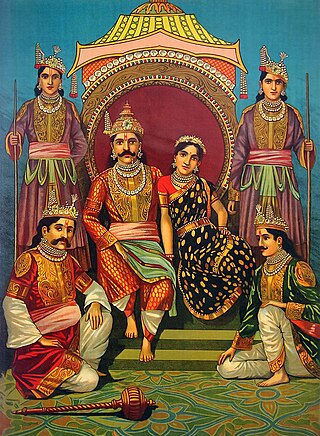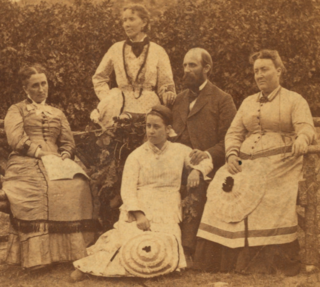
Marriage, also called matrimony or wedlock, is a culturally and often legally recognised union between people called spouses. It establishes rights and obligations between them, as well as between them and their children, and between them and their in-laws. It is nearly a cultural universal, but the definition of marriage varies between cultures and religions, and over time. Marriage becomes a social construct to adjudicate the conflicts of interest between consenting individuals and a transactional means to fulfill their needs. Typically, it is an institution in which interpersonal relationships, usually sexual, are acknowledged or sanctioned. In some cultures, marriage is recommended or considered to be compulsory before pursuing sexual activity. A marriage ceremony is called a wedding, while a private marriage is sometimes called an elopement.

Polygyny is the most common and accepted form of polygamy around the world, entailing the marriage of a man with several women. The term polygyny is from Neoclassical Greek πολυγυνία (polugunía); from Ancient Greek πολύ (polú) 'many', and γυνή (gunḗ) 'woman, wife'.

Polyandry is a form of polygamy in which a woman takes two or more husbands at the same time. Polyandry is contrasted with polygyny, involving one male and two or more females. If a marriage involves a plural number of "husbands and wives" participants of each gender, then it can be called polygamy, group or conjoint marriage. In its broadest use, polyandry refers to sexual relations with multiple males within or without marriage.
Polygamy is the practice of marrying multiple spouses. When a man is married to more than one wife at the same time, sociologists call this polygyny. When a woman is married to more than one husband at a time, it is called polyandry. In sociobiology and zoology, researchers use polygamy in a broad sense to mean any form of multiple mating.

Polyamory is the practice of, or desire for, romantic relationships with more than one partner at the same time, with the informed consent of all partners involved. People who identify as polyamorous may believe in open relationships with a conscious management of jealousy and reject the view that sexual and relational exclusivity (monogamy) are prerequisite for deep, committed, long-term, loving relationships. Others prefer to restrict their sexual activity to only members of the group, a closed polyamorous relationship that is usually referred to as polyfidelity.

The Oneida Community was a perfectionist religious communal society founded by John Humphrey Noyes and his followers in 1848 near Oneida, New York. The community believed that Jesus had already returned in AD 70, making it possible for them to bring about Jesus's millennial kingdom themselves, and be perfect and free of sin in this world, not just in Heaven. The Oneida Community practiced communalism, group marriage, male sexual continence, Oneida stirpiculture, and mutual criticism.

Sexuality and gender identity-based cultures are subcultures and communities composed of people who have shared experiences, backgrounds, or interests due to common sexual or gender identities. Among the first to argue that members of sexual minorities can also constitute cultural minorities were Adolf Brand, Magnus Hirschfeld, and Leontine Sagan in Germany. These pioneers were later followed by the Mattachine Society and the Daughters of Bilitis in the United States.
Swinging, sometimes called wife-swapping, husband-swapping, or partner-swapping, is a sexual activity in which both singles and partners in a committed relationship sexually engage with others for recreational purposes. Swinging is a form of non-monogamy and is an open relationship. People may choose a swinging lifestyle for a variety of reasons. Practitioners cite an increased quality and quantity of sex. Some people may engage in swinging to add variety into their otherwise conventional sex lives or due to their curiosity. Some couples see swinging as a healthy outlet and means to strengthen their relationship.

Polygamy was practiced by leaders of the Church of Jesus Christ of Latter-day Saints for more than half of the 19th century, and practiced publicly from 1852 to 1890 by between 20 and 30 percent of Latter-day Saint families.

A ménage à trois is a domestic arrangement or committed relationship consisting of three people in polyamorous romantic or sexual relations with each other, and often dwelling together. The phrase is a loan from French meaning "household of three". Contemporary arrangements are sometimes identified as a throuple, thruple, or triad.
Polyfidelity is a form of non-monogamy, a romantic relationship structure in which all members are considered equal partners and agree to restrict sexual and/or romantic activity only to other members of the group.

John Humphrey Noyes was an American preacher, radical religious philosopher, and utopian socialist. He founded the Putney, Oneida and Wallingford Communities, and is credited with coining the term "complex marriage".
Non-monogamy is an umbrella term for every practice or philosophy of non-dyadic intimate relationship that does not strictly hew to the standards of monogamy, particularly that of having only one person with whom to exchange sex, love, and/or affection. In that sense, "nonmonogamy" may be accurately applied to extramarital sex, group marriage, or polyamory. It is not synonymous with infidelity, since all parties are consenting to the relationship structure, partners are often committed to each other as well as to their other partners and cheating is still considered problematic behavior with many non-monogamous relationships.
The type, functions, and characteristics of marriage vary from culture to culture, and can change over time. In general there are two types: civil marriage and religious marriage, and typically marriages employ a combination of both. Marriages between people of differing religions are called interfaith marriages, while marital conversion, a more controversial concept than interfaith marriage, refers to the religious conversion of one partner to the other's religion for sake of satisfying a religious requirement.
A committed relationship is an interpersonal relationship based upon agreed-upon commitment to one another involving love, trust, honesty, openness, or some other behavior. Forms of committed relationships include close friendship, long-term relationships, engagement, marriage, and civil unions.
Polygamy is "the practice or custom of having more than one wife or husband at the same time." Polygamy has been practiced by many cultures throughout history.

Joseph Smith, the founder of the Latter Day Saint movement, privately taught and practiced polygamy. After Smith's death in 1844, the church he established splintered into several competing groups. Disagreement over Smith's doctrine of "plural marriage" has been among the primary reasons for multiple church schisms.

Polygamy, including polygyny, is outlawed in India. While it was not prohibited in Ancient India and was common among aristocrats and emperors, it is believed that it was not a major cultural practice. The lack of prohibition was in part due to the separation between land laws and religion, and partially since all of the major religions of India portrayed polygamy in a neutral light.

Polyandry in India refers to the practice of polyandry, whereby a woman has two or more husbands at the same time, either historically on the Indian subcontinent or currently in the country of India. An early example can be found in the Hindu epic Mahabharata, in which Draupadi, daughter of the king of Panchala, is married to five brothers.
Polygamy is legal in Bhutan regarding the consent of future wives. There is no legal recognition granted to polygamous spouses under civil law of Bhutan or customary law. Women in Bhutan may by custom be married to several husbands, however they are allowed only one legal husband. The legal status of married couples among polygamous and polyandrous households impacts the division of property upon divorce and survivorship, as well as general admissibility of the marital relationship in courts.










